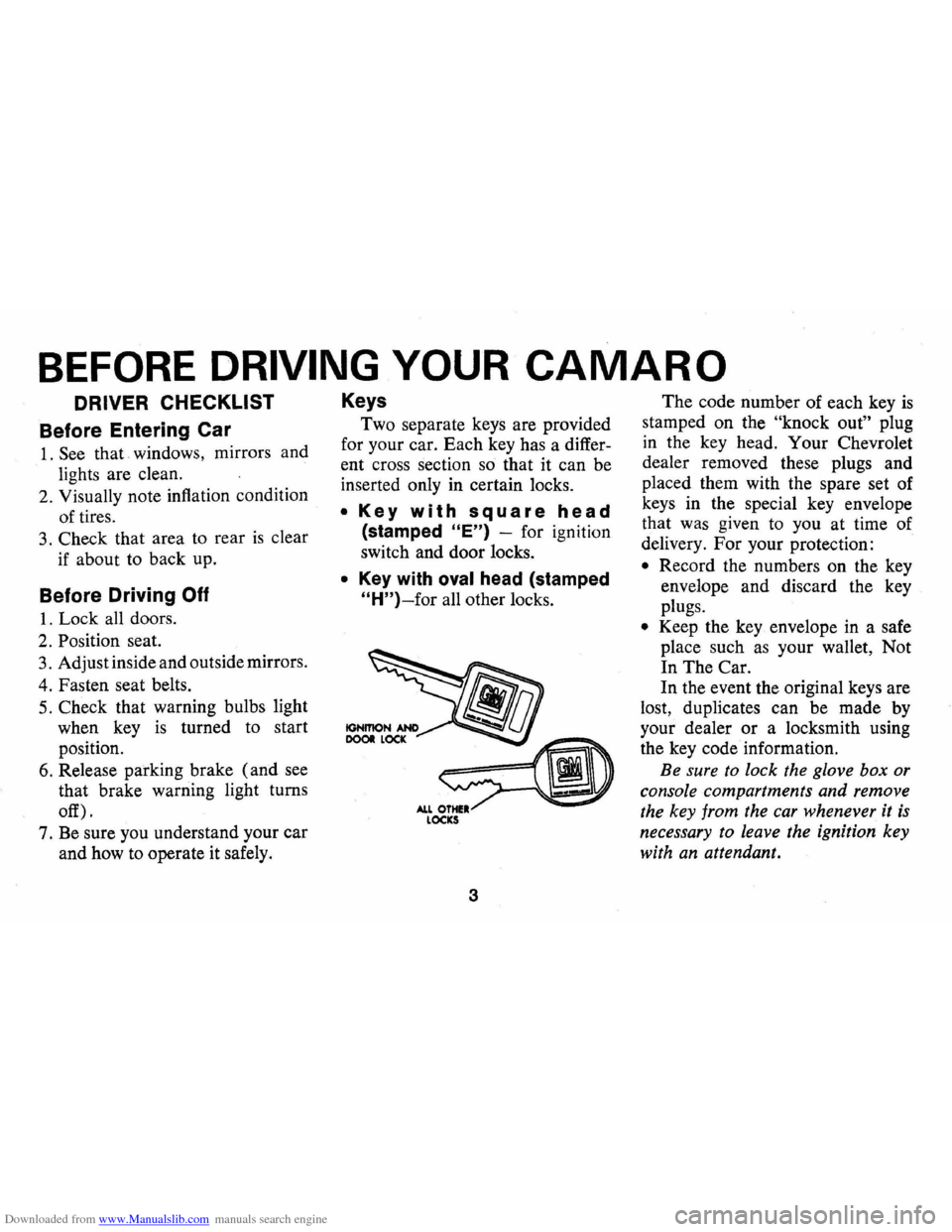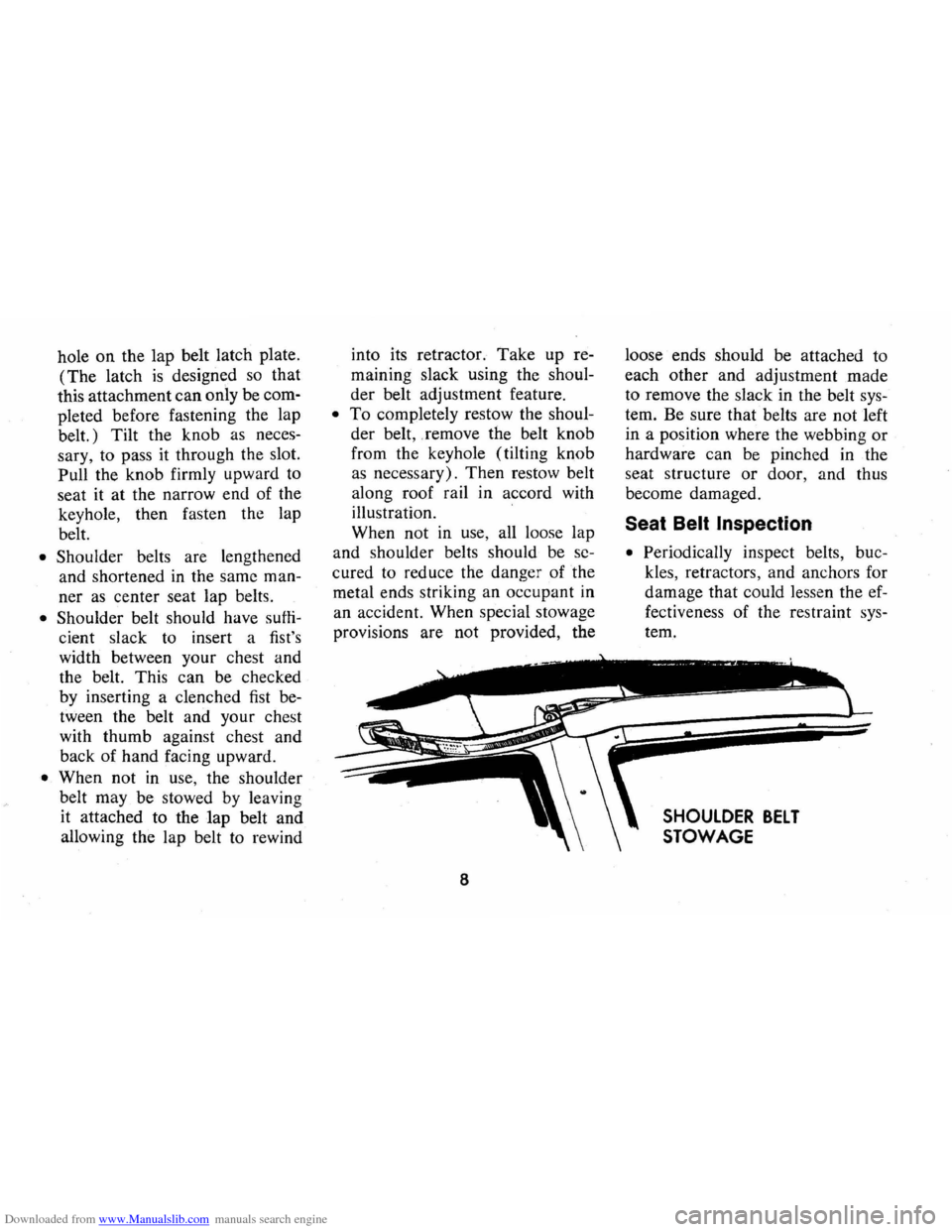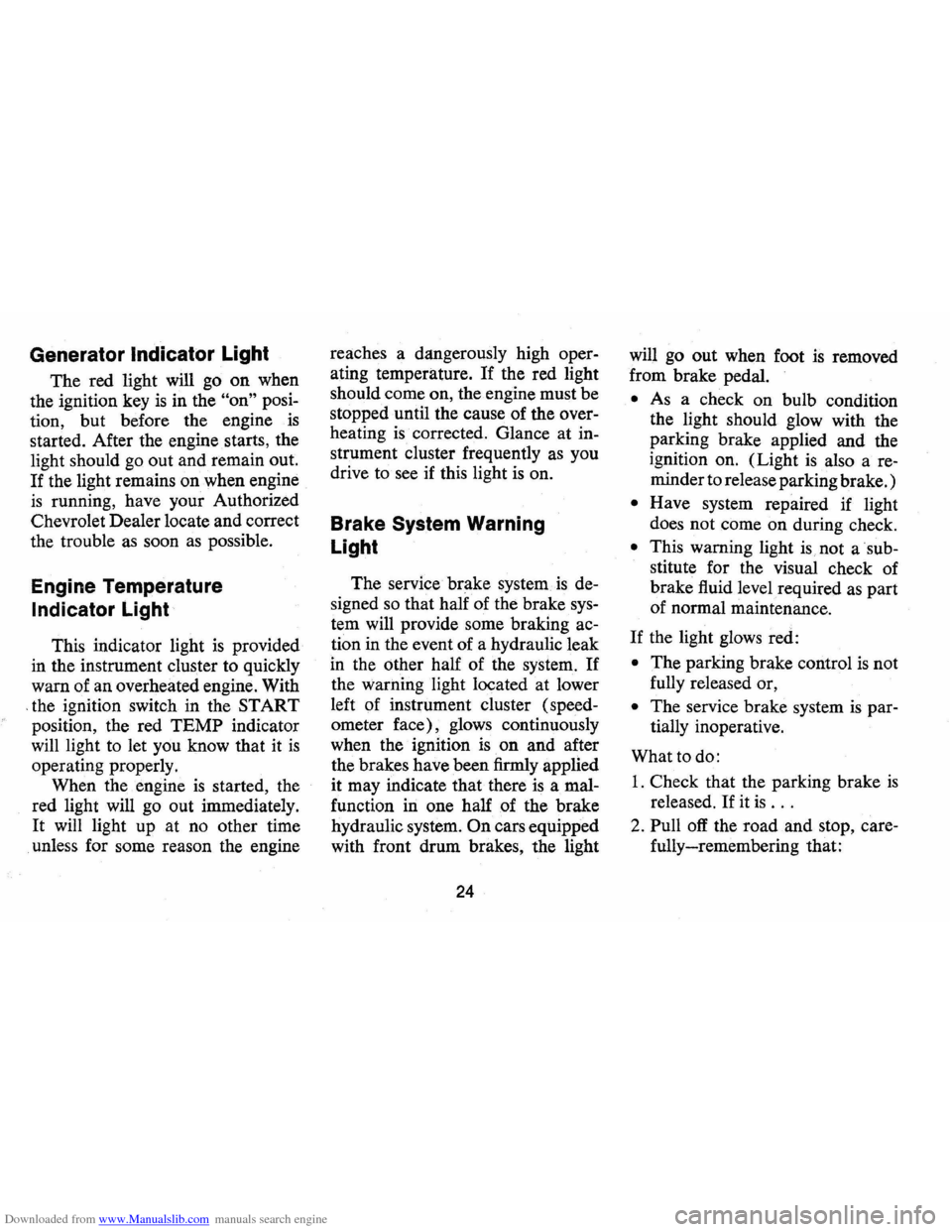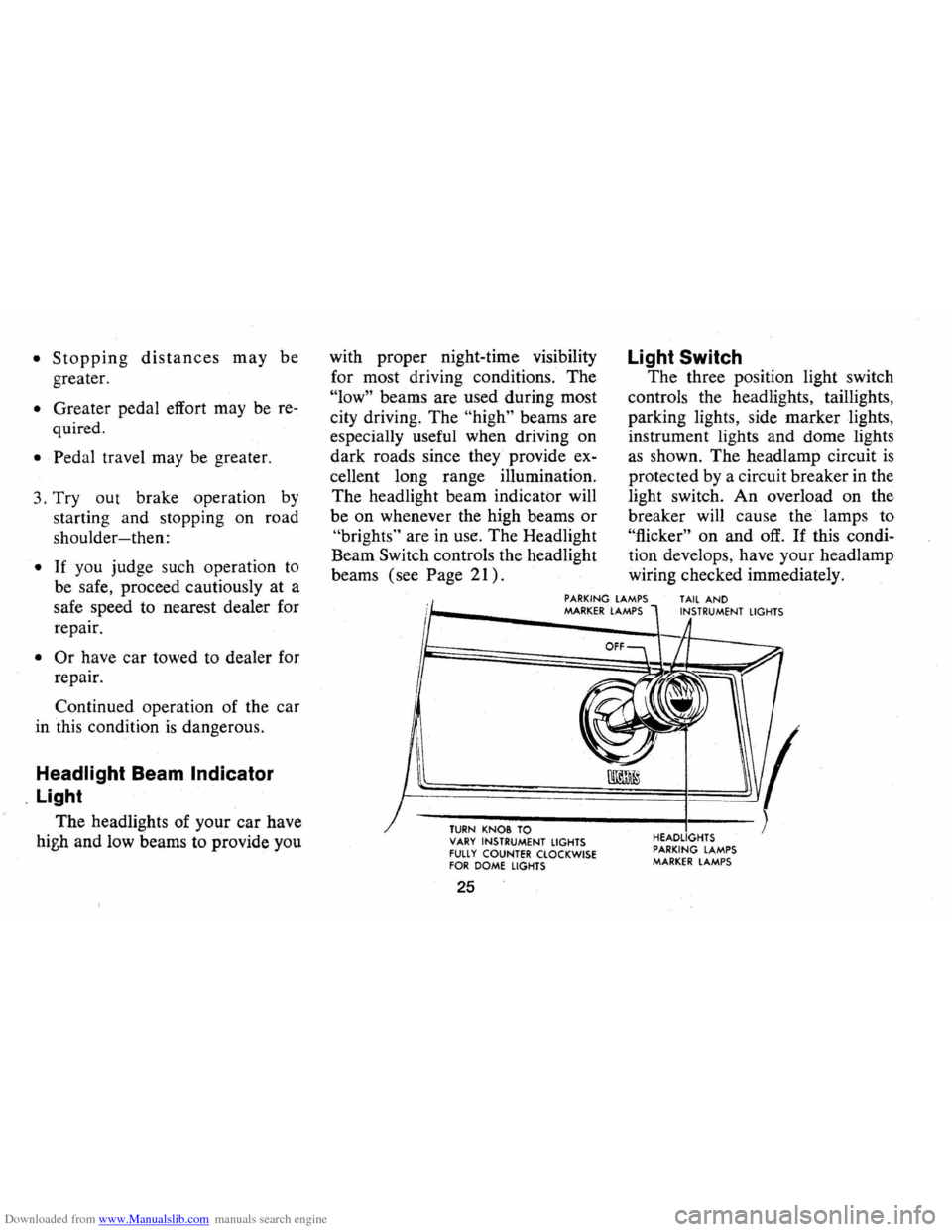1973 CHEVROLET CAMARO check engine
[x] Cancel search: check enginePage 6 of 84

Downloaded from www.Manualslib.com manuals search engine BEFORE DRIVING YOUR CAMAR 0
DRIVER CHECKLIST
Before Entering Car
1. See that windows, mirrors and
lights are clean.
2. Visually note inflation condition
of tires.
3. Check that area to rear is clear
if about to back up.
Before Driving Off
1. Lock all doors.
2. Position seat.
3 . Adjust inside and outside mirrors.
4. Fasten seat belts.
5. Check that warning bulbs light
when key
is turned to start
position.
6. Release parking brake (and
see
that brake warning light turns
off) .
7. Be sure you understand your car
and how to operate it safely.
Keys
Two separate keys are provided
for your car. Each key has a differ
ent cross section
so that it can be
inserted only in certain locks.
• Key with square head
(stamped "E") -for ignition
switch and door locks.
• Key with oval head (stamped
"H")-for all other locks.
3
The code number of each key is
stamped on the "knock out" plug
in the key head. Your Chevrolet
dealer removed these plugs and
placed them with the spare set of
keys in the special key envelope
that was given to you at time of
delivery. For your protection:
• Record the numbers on the key
envelope and discard the key
plugs.
• Keep the key envelope in a safe
place such
as your wallet, Not
In The Car.
In the event the original keys are
lost, duplicates can be made by
your dealer
or a locksmith using
the key code information.
Be sure
to lock the glove box or
console compartments and remove
the key from the car whenever it
is
necessary to leave the ignition key
with an attendant.
Page 11 of 84

Downloaded from www.Manualslib.com manuals search engine hole on the lap belt latch plate.
(The latch is designed so that
this attachment
can only be com
pleted before fastening the lap
belt.) Tilt the knob
as neces
sary, to pass it through the slot.
Pull the knob firmly upward to
seat it at the narrow end of the
keyhole, then fasten the lap
belt.
• Shoulder belts are lengthened
and shortened
in the same man
ner
as center seat lap belts.
• Shoulder belt should have suffi
cient slack to insert a fist's
width between your chest and
the belt. This can be checked
by inserting a clenched
fist be
tween the belt and your chest
with thumb against chest and
back of hand facing upward.
• When not in use, the shoulder
belt may be stowed by leaving
it attached to the lap belt and
allowing the lap belt to rewind into
its retractor. Take up re
maining slack using the shoul
der belt adjustment feature.
• To completely restow the shoul
der belt, .remove the belt knob
from the keyhole (tilting knob
as necessary). Then restow belt
along roof rail in accord with
illustration. .
When not in use, all loose lap
and shoulder belts should be se
cured to reduce the danger of
the
metal ends striking an occupant in
an accident. When special stowage
provisions are not provided, the
8 loose
ends should be attached to
each other and adjustment
made
to remove the slack in the belt sys
tem. Be sure that belts are not left
in a position where the webbing
or
hardware can be pinched in the
seat structure
or door, and thus
become damaged.
Seat Belt Inspection
• Periodically inspect belts, buc
kles, retractors, and anchors for
damage that could lessen the ef
fectiveness
of the restraint sys
tem.
SHOULDER BELT
STOWAGE
Page 12 of 84

Downloaded from www.Manualslib.com manuals search engine • Keep sharp edges and damaging
objects away from belts.
• Replace belts if cut, weakened,
frayed, or subjected to collision
loads.
• Check that anchor mounting
bolts are tight.
• Have questionable parts re
placed.
• Keep seat belts clean and dry.
• Clean only with mild soap solu
tion and lukewarm water.
• Do not bleach or dye belts since
this may severely weaken belts.
Child Restraint
Children in automobiles · should
be restrained to lessen the risk of
injury in accidents, sudden stops
or other hazardous situations.
General Motors dealers offer re
straint systems designed specific
ally for use with infants. In using
any infant or child restraint
sys
tem, read and comply with all in- stallation
and usage instructions.
All unused seat belts near the
child should be stowed properly to
help prevent them from striking
him in the event of an accident.
Lap belts and shoulder belts with
out storage provisions should have
buckles latched and belts adjusted
to remove slack.
Cars Not Equipped With
Special Child Restraints
If a child is traveling in a vehi
cle not equipped with a General
Motors
inf~mt restraint or other
safe infant or child restraint
sys
tem, . the following precautions
should be taken:
1. Infants unable to sit up by
themselves should be restrained
by placing them in a covered,
padded bassinet which
is placed
crossways in the vehicle (width
wise) on the rear seat. The bas
sinet should be securely re
strained with the regular vehi-
9
cle seat belts. An alternate me
thod
is to position the bassinet
so that it rests against the back
of the front seat, again cross
ways in the vehicle.
2. Children able to sit up by them
selves should be placed on a
seat and lap belted, preferably
in the rear seat. Never allow a
child to stand or kneel on any
seat.
If the child cannot see out
the car windows he should sit
on a firm cushion with the reg
ular lap belt restraining him at
the hips. The cushion should be
as firm as practical and just
high enough to enable the child
to look horizontally out of the
car windows. The use of the
cushion should be discontinued
as soon as the child is old
enough to see out of the car
windows without it.
3. General Motors recommends
that children be restrained
Page 13 of 84

Downloaded from www.Manualslib.com manuals search engine properly when riding. However,
if unusual conditions prohibit
use of restraints and require
Trailer Hauling
Since passenger cars are designed
and intended to be used primarily
as passenger conveyances, towing
a trailer will affect handling, dura
bility and economy. Maximum
safety and satisfaction depends
upon proper use of correct equip
ment and· avoiding overloads and
other abusive operation.
The maximum loaded trailer
weight which you can pull with your
Camaro depends on what special
equipment has been installed on
your car. Chevrolet does not rec
ommend towing any trailer unless
the car
is properly equipped. Infor
mation
ori trailer hauling capabili
ties, special equipment required,
and optional equipment offered
by
Chevrolet is available from your that
a child must stand,
he
should stand on the floor direct
ly behind the front seat. This will
Chevrolet Dealer or by wntmg:
Chevrolet Motor Division, Detroit,
Michigan 48202
(or in Canada
by writing to General Motors of
Canada Limited,
Owner Relations
Department,
Oshawa, Ontario).
To assist
in attaining good han
dling of the car-trailer combina
tion, it
is important that the trailer
tongue load be maintained at ap
proximately 10% of the loaded
trailer weight. Tongue loads can
be
adjusted by proper distribution of
the load in the trailer, and can
be
checked by weighing separately
the loaded trailer and then the
tongue.
When towing trailers, tires should
be inflated to the highest infla
tion pressures shown on the placard
10
help minimize the possibility of
injury from frontal impacts in
the event of an accident.
affixed to the left front door. The
allowable passenger and cargo
load, also shown on the same plac
ard,
is reduced by an amount equal
to the trailer tongue load on the
trailer hitch.
Maintenance
More frequent vehicle mainte
nance
is required when using your
car to pull a trailer. Change the:
• Automatic transmission fluid
each
12,000 miles,
• Rear axle fluid each 12,000
miles,
• Engine oil each 60 days or 3,000
miles, whichever occurs first,
• Positive crankcase ventilation
valve each 12 months or
12,000
miles, whichever occurs first.
Page 21 of 84

Downloaded from www.Manualslib.com manuals search engine ing wheel. The lever is moved up
ward to signal a right turn and
downward
to signal a left turn.
Lamps on the front and rear of the
car transmit this signal to other
motorists and pedestrians. The
ig
nition switch must be in the "ON"
position in order for the turn sig
nals to be operational. This feature
prevents battery drain
if the lever
is left in an "ON" position when
your car
is not in use.
In a normal turning situation
such
as turning a corner, the turn
signal
is cancelled automatically
after the turn
is completed. How
ever, in some driving maneuvers
such as changing lanes
on an ex
pressway, the steering wheel
is not
turned back sufficiently after com
pleting the turn to automatically
cancel the turn signal. For con
venience in such maneuvers, the
driver can flash the
tum signals by moving
the turn signal lever part
way (to the first stop) and holding
it there. The lever returns to the
neutral
or cancelled position when
the driver releases his hold on the
lever.
A green light on the instrument
cluster flashes to indicate proper
operation of the front and rear turn
signal lamps.
If the indicator lamp
18
remains on and does not flash,
check for a defective lamp bulb.
If
the indicator fails to light when the
lever
is moved, check the fuse and
indicator bulb.
Power Steering
If the steering system power as
sist fails due to some malfunction,
or because the engine has stalled,
the car can still be steered.
How
ever, much greater effort is re
quired, particularly in sharp turns.
Holding Car on an Upgrade
When stopped on an upgrade,
maintain your position by applying
the brakes. Never hold the car in
place
by accelerating engine with
transmission in gear. This could
cause damage by overheating the
transmission (automatic) or clutch
(manual).
Page 24 of 84

Downloaded from www.Manualslib.com manuals search engine REMINDER: Brake linings should
be inspected for wear by a qualified
mechanic at least once a year
or
every 12,000 miles, whichever oc
curs first (disc brake pads should
be visually inspected for wear each
time the wheels and tires are ro
tated at
6,000 mile intervals).
More frequent inspections should
be made if driving conditions in
your area, such as traffic or terrain
or techniques of individual
driver~
result in frequent brake applica
tions. Your Chevrolet dealer
is best
qualified to advise you
as to how
often this inspection should be per
formed. When brakes require re
lining, use those Genuine General
Motors
Parts specified for your car,
and Delco, brake fluid
as required.
Automatic Brake Adjusters
• Brakes on this car (except for
the parking brake) are self- adjusting,
designed to eliminate
periodic brake adjustments.
• Drum brake adjustment is made
automatically
as the brakes are
applied while car
is moving
backwards.
• Disc brake adjustment is made
automatically with each brake
application.
• If excess brake pedal travel de
velops, drive alternately back
ward and forward several times
and apply brakes firmly in each
direction.
• See your dealer if normal pedal
travel
is not restored, or if there
is a rapid increase in pedal travel,
which could be a sign of other
brake trouble.
Clutch Adjustment
Clutch adjustment should be
checked and adjusted periodically
as necessary to compensate for
21
clutch facing wear. To check, de
press pedal by hand until resistance
is felt. Free travel of pedal should
~e approximately one inch; if very
httle
or no free travel is evident
clutch adjustment
is required. '
Headlight Beam Switch
"High" and "low" headlight
beams are controlled by the floor
button at your left foot. The indi
cator, located in the speedometer
dial, will light up when the high
beams are in use.
I
Page 27 of 84

Downloaded from www.Manualslib.com manuals search engine Generator Indicator Light
The red light will go on when
the ignition key
is in the "on" posi
tion, but before the engine
is
started. After the engine starts, the
light should go out and remain out.
If the light remains on when engine
is running, have your Authorized
Chevrolet Dealer locate and correct
the trouble as soon
as possible.
Engine Temperature
Indicator Light
This indicator light is provided
in the instrument cluster to quickly
warn of an overheated engine. With
,the ignition switch in the START
position, the red
TEMP indicator
will light to let you know that it
is
operating properly.
When the engine
is started, the
red light will go out immediately.
It will light up at no other time
unless for some reason the engine reaches
a dangerously high oper
ating temperature.
If the red light
should come on, the engine must be
stopped until the cause of the over
heating
is corrected. Glance at in
strument cluster frequently
as you
drive to see if this light
is on.
Brake System Warning
Light
The service brake system is de
signed
so that half of the brake sys
tem will provide some braking ac
tion in the event of a hydraulic leak
in the other half of the system.
If
the warning light located at lower
left of instrument cluster (speed
ometer face), glows continuously
when the ignition
is on and after
the brakes have been firmly applied
it may indicate that there
is a mal
function in one half of the brake
hydraulic system.
On cars equipped
with front drum brakes, the light
24
will go out when foot is removed
from brake pedal.
• As a check on bulb condition
the light should glow with the
parking brake applied and the
ignition on. (Light
is also a re
minder to release parking brake.)
• Have system repaired if light
does not come
on during check.
• This warning light is. not a' sub
stitute for the visual check of
brake fluid level required
as part
of normal maintenance.
If the light glows red:
• The parking brake control is not
fully released or,
• The service brake system is par
tially inoperative.
What to do:
1. Check that the parking brake is
released. If it is ...
2. Pull off the road and stop, care
fully-remembering that:
Page 28 of 84

Downloaded from www.Manualslib.com manuals search engine • Stopping distances may be
greater.
• Greater pedal effort may be re
quired .
• Pedal travel may be greater.
3.
Tryout brake operation by
starting and stopping on road
shoulder-then:
• If you judge such operation to
be safe, proceed cautiously at a
safe speed to nearest dealer for
repair.
• Or have car towed to dealer for
repair.
Continued operation of the car
in this condition
is dangerous.
Headlight Beam Indicator
Light
The headlights of your car have
high and low
beams to provide you with
proper night-time visibility
for most driving conditions. The
"low" beams are used during most
city driving. The
"high" beams are
especially useful when driving on
dark roads since
they' provide ex
cellent long range illumination.
The headlight beam indicator will
be on whenever the high beams
or
"brights" are in use. The Headlight
Beam Switch controls the headlight
beams (see Page
21).
Light Switch
The three position light switch
controls the headlights, taillights,
parking lights, side marker lights,
instrument lights and dome lights
as shown. The headlamp circuit is
protected by a circuit breaker in the
light switch.
An overload on the
breaker will cause the lamps to
"flicker" on and off. If this condi
tion develops, have your headlamp
wiring checked immediately.
PARKING LAMPS MARKER LAMPS TAIL AND INSTRUMENT LIGHTS
TURN KN08 TO VARY INSTRUMENT LIGHTS FUll Y COUNTER CLOCKWISE FOR DOME LIGHTS
25
HEADLIGHTS
PARKING LAMPS MARKER LAMPS